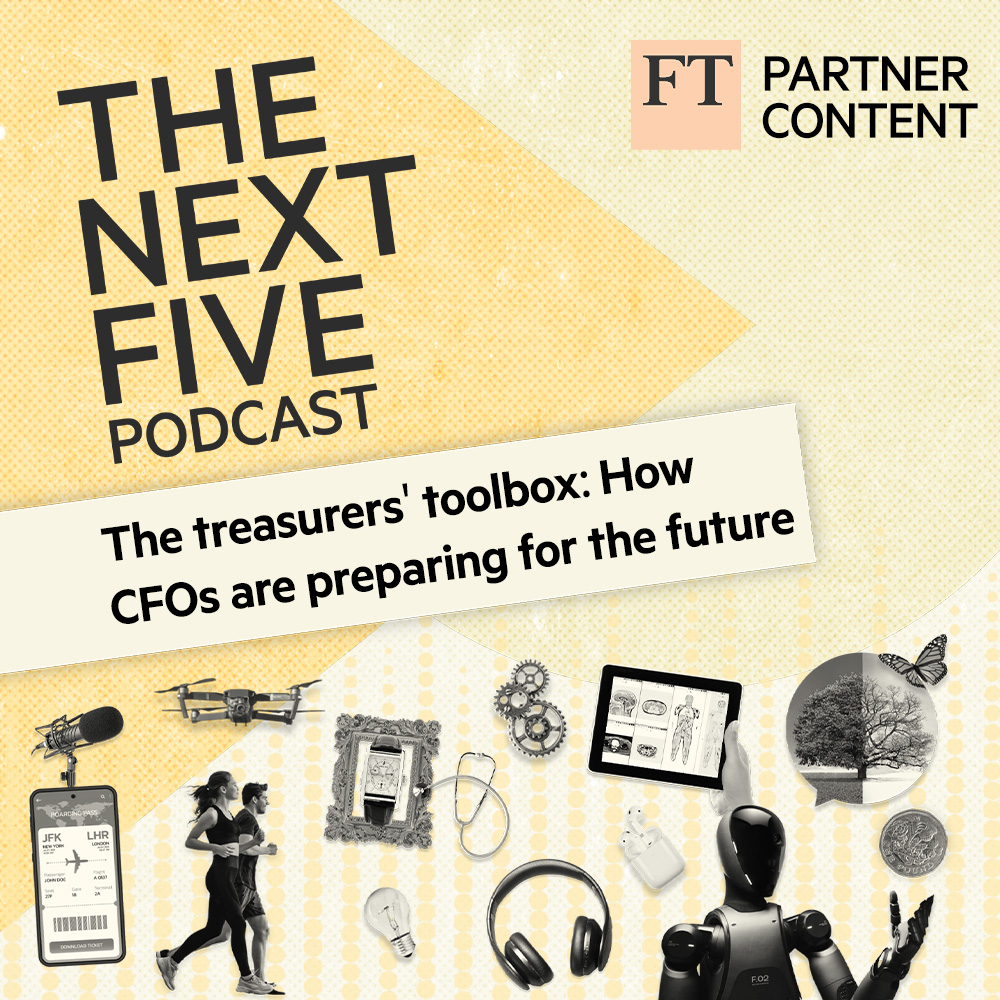THE NEXT FIVE
THE NEXT FIVE - EPISODE 13
Electric Future: The Road To EV Supremacy
Money makes the wheels go round: Industry leaders tackle the EV funding gap






































The Next Five is the FT’s partner-supported podcast, exploring the future of industries through expert insights and thought-provoking discussions with host, Tom Parker. Each episode brings together leading voices to analyse the trends, innovations, challenges and opportunities shaping the next five years in business, geo politics, technology, health and lifestyle.
















Featured in this episode:
Tom Parker
Executive Producer & Presenter
Adrian Chai
Managing Director, Institutional Banking Group at DBS Bank
Pras Ganesh
Executive Vice President & Corporate Information Security Officer at Toyota
Mike Whittington
Head of Global Sales and Network at Polestar
EVs are already displacing 1.5million barrels of oil usage per day or 3% of total road fuel demand, however emissions from vehicles are still responsible for between 12-16% of global emissions.
But now imagine a world where there are no ICE (Internal Combustion Engine) cars on the road. That’s the future that is needed if we are to hit net zero targets. To realise this by mid century annual EV sales must hit 138 million units by 2040.
In this episode of The Next Five podcast we take a deep-dive into the current landscape, tackle the future for EVs from industry leaders in the legacy and pure EV space, and highlight the opportunities and challenges along the way. Adrian Chai, Managing Director, Institutional Banking Group at DBS Bank discusses the gaps in finance in the EV value chain and where capital needs to flow to support the industry growth, as well as the future of the fast evolving battery market. Pras Ganesh, Executive Vice President & Corporate Information Security Officer at Toyota talks about the challenges and opportunities that legacy automakers have in the space, how capital investment is front loaded in new technologies and calls for a just transition. Mike Whittington, Head of Global Sales and Network at Polestar offers insight from a pure EV business model, extolling the need for supportive policy and greater investment into infrastructure globally to meet climate targets.
Our Sources for the show: FT Resources, IEA, Mckinsey, BNEF, WEF, Reuters, Forbes.
READ TRANSCRIPT
- Tech
- Finance
- Climate
Transcript
Electric Future: The Road To EV Supremacy
Soundbites:
Mike:00:42 last year, the Evie market grew by around 55%
Pras: 13:40: introducing a new technology is always an expensive aspect
Adrian: 6:03 the biggest funding needs is in the upstream segment
TOM 00:03
I'm Tom Parker, and welcome to the next five podcast brought to you by the FT partner studio. In this series, we ask industry experts about how their world will change in the next five years, and the impact it will have on our day to day. In this episode, we take a deep-dive into the current Electric Vehicle landscape and tackle the future for EVs from industry leaders in the legacy and pure EV space as they highlight the opportunities and challenges along the way.
TOM: 00:40
EVs are already displacing 1.5million barrels of oil usage per day or 3% of total road fuel demand, however emissions from vehicles are still responsible for between 12-16% of global emissions. But now imagine a world where there are no ICE (Internal Combustion Engine) cars on the road. That’s the future that is needed if we are to hit net zero targets. To realise this by mid century annual EV sales must hit 138 million units by 2040, a huge increase on the 10 million sold in 2022. Boston Consulting Group predicts that by 2028 light Battery Electric Vehicles will outstrip global sales of ICE vehicles and by 2035 account for 59% of light vehicles sold worldwide.
Mike Whittington: 00:35
The global Evie market has been growing at a very rapid pace over the last few years
TOM: 02:17 This is Mike Whittington, Head of Global Sales and Network at Polestar
In fact, last year, the Evie market grew by around 55%, so quite a considerable growth and some of the projections for the end of this year, around 14 million pure battery electric vehicles. So significant growth in the market. So the growth is definitely there. And it's driven by greater choice of products and investment in charging infrastructure. And of course, climate aspirations that both private consumers and companies have in terms of how we address the climate challenges around the world. And also supported by fiscal incentives that many marketers have put in place for electric vehicles. And overall, I'd say there's a growing awareness of the environmental benefits of electric vehicles.. For pollsters we're, you know, we're a young brand or a new brand. We've seen rapid growth over the last few years, we've now got around about 120,000 cars on the road across 27 markets. So we're growing at a rapid pace as is the market.
TOM:02:28 Building the EV value chain comes at a cost, a multi trillion dollar one. Access to public equity markets is challenging for most and so private investment holds the key in charging the EV market to its full potential, a $53 trillion market opportunity between now and 2050.
Adrian Chai: 05:29
Well, the EDI value chain is actually very white space with a mix of traditional automotive players, very large across industry players as well as emerging new players in the ecosystem.
TOM:03:07 This is Adrian Chai, Managing Director, Institutional Banking Group, DBS Bank
And these electrification trends are definitely translating into a multi trillion investment opportunities across the entire value chain. So, I mean, right now, I think the biggest funding needs is in the upstream segment, right, given the shift in the powertrain with new power trains and drive trains, accounting for about 43% of the overall costs of an Evie as we call it. So if we were to say broaden this to the whole supply chain, including the even more upstream metals pack as well as the intermediate products, that goes into a battery, the funding needs is even bigger. Right. So, the other area where we see large funding needs to support the acceleration of Evie adoption is actually in the charging infrastructure space, where you know, the cumulative investment is expected to be around 150 billion by 2025 and exceed 1 trillion by 2040. So based on our understanding of the value chain, right, the larger players such as the traditional carmakers OEMs for them to transition into EVs as well as you know the large Evie battery players investing in global plants, these guys are able to access funding fairly well right through their existing cash flows or debt financing via the public markets ECAs banks like ourselves as well as the equity capital markets right. So, for the big boys generally is not a problem right. So, the the actual funding gap right now is across three broad categories I would say right I think first of all the emerging new suppliers such as the smaller Evie battery various or the intermediate products that go into the batteries such as you know cathode makers and make precursor separators you know, there are a lot of these layers right. And the other one is of course, you know, the pure play you EDI OEMs without the legacy cash flows or scale right now, right and the capital investment for them is actually very high. And lastly, right the standalone charging infrastructure and mobility companies which actually need longer gestation periods, as well as economies of scale in order to be financially viable. So these are actually the gaps
TOM:03:15 Legacy automakers face a two-fold challenge: a decline in ICEV demand and the need to adapt to the electrified future at the pace most governments and consumers are demanding. Focusing on EVs is expensive for legacy car makers; Ford Motor Co announced in March 2023 that it expects to make a $3bn pretax loss in its EV unit. But it isn’t stopping traditional carmakers from investing in the sector. Toyota, the world’s largest automaker, is investing $35bn into pure EVs, launching 30 models by 2030 with the aim to sell 3.5mn BEVs annually by the same date.
So investment is an absolutely critical element,
TOM: 04:13 This is Pras Ganesh, Executive Vice President and CISO at Toyota’s Asia Head Office
essentially, because this is about the time when we have to look at changing a lot of the overall business model itself. When we start talking about electrified vehicles, this is not just about making the vehicle but it's also about changing a lot of the supply chain, changing a lot of how the dealer network operates all of these kinds of elements. In 2021, we announced that we would invest around a trillion yen around $70 billion in electrification, half of that about $35 billion in battery electric vehicles, and around 35 billion in terms of the other space of other electrified vehicles, including hybrid electric or plug-in hybrid electric vehicles as well. So we have made quite a huge investment in terms of electrification as well.
Pras Ganesh: 13:37 So I think when we start talking about any new technology, introducing a new technology is always an expensive aspect, we need to ensure that we are able to first invest on the technology and make sure that the technology gets to the point where it's safe, where it's appropriate for the customers where it actually meets the customer's requirements. And then we can start scaling it. And as we continue to scale, we will find economic merit. So in that context, even if we're looking at electric vehicles and the investments required for electric vehicles, we believe that this is one of the critical pathways that we have to work on towards carbon neutrality. So we have to invest in battery electric vehicles or fuel cell electric vehicles, which will support us in this transition to more electrified or more carbon neutral or carbon reducing vehicles as well. So in that context, we believe that this kind of an investment is like planting the seeds for the future of the company naturally, which I believe is the same kind of thinking that Ford or any other car company and even currently, the financial markets also are starting to reward companies that are making this kind of a transition as well.
TOM: 04:23 To really solve the emissions issue, scope 1, 2 and both upstream and downstream scope 3 need to be tackled together. A big challenge; one where funding, industry innovation and collaboration is required, at pace.
10:19 So we set ourselves a very ambitious goal, a moonshot goal that we call it, which is Pollstar zero to develop a production car that's Climate Neutral by 2030. And it really underpins our passion. And a focus around sustainability is one of our core brand pillars. And the beauty of this moonshot goal is that we don't know how to do it yet. It's going to involve significant collaboration with experts around the industry, in their own fields, everything from tire production, aluminium production, you know, some of the composites and materials used in the car, because every part of the production process going into the vehicle is going to have to also achieve the same objective. We have a significant number of industry experts, partners now that have signed up to work with us that are taking this challenge with us. And that's very exciting in its own right. And I believe that it really shows how passionate we are about the sustainability agenda. And that we see it as massively important to improve the climate that we live in through the electrification of electric vehicles.
Clearly, there is a cost in developing electric vehicles, everything from the platforms to the cars themselves and the technology. For Pollstar, we have an asset light business model. We're obviously part of a large Volvo and Geely Corporation. And we work with the experts in the industry, whether that's developing technologies like LIDAR There are other technologies in the car. So we're not looking to develop and build everything ourselves or invest in every part of the technology. We're looking for strategic partnerships with the experts in the industry. Another example is being the first car with Google embedded in the car. So actually addressing it through the experts in whatever industry field it takes, in order to bring the best cars to market. So that's how we approach it within the pollster.
Tom: Pras, your thoughts?
Pras Ganesh:
When we're looking at as a legacy automaker moving to electrify vehicles, the critical issue is the transition. How do we make the transition appropriately at the right speed for the right products in the right market? So we need to ensure that we're doing it in the right space and the right time. But the critical aspect that we have to think about when we look at the challenge, and the transition for electrification, is actually ensuring that all of the stakeholders that we work with are able to transition along with us, Toyota has a very strong belief that we actually have to work by leaving no one behind, you know, in light, kind of the SDG principles. So when we're talking about leaving no one behind, who are we talking about, of course, we have to look at the customers. And for a diverse set of customers, we have to give them a diverse set of options as well, which actually meet their usage needs, which meet their economic needs, we have to also understand how we manage our suppliers and our supply chain.
TOM: 04:47
EVs consume energy about three times more efficiently than traditional ICE vehicles but batteries are still a major focus for innovation. As battery demand rises in the sector, global capacity is expected to see a 5x growth from 800GWh in 2021 to 4000GWh by 2030. This puts huge demand on key commodities (EVs use 6 times more minerals in construction than ICE vehicles and by 2040 demand will see a 30 fold increase). Nickel is a key element in battery manufacturing. Currently 70% of Nickel supply goes to the steel industry, with just 5% used in batteries. But by the end of this decade batteries are expected to demand 35% of supply. Lithium demand is also a concern, with BCG predicting lithium supply will fall 4% lower than demand in 2030, and 24% by 2035. The falling cost and improved performance of lithium ion batteries has been one of the main drivers for the uptake of EVs to date, but with demand set to outstrip supply, it could cause a challenge to the industry. This begs the question, what needs to be done with battery innovation so that EVs have a long, sustainable future?
Tom: Pras?
Pras Ganesh: So when we started looking at the overall space for battery electric vehicles, as well as the battery supply chain, there will definitely be some forms of shortage coming in the next few years, and probably going on. Because even to get a new lithium mine ready based on some estimates, it's going to take between 10 to 15 years for such a lithium mine to actually come on board. So even if there's a lot of investment happening right now, the actual resources will only be readied maybe 1015 years later. So in that context, we need to understand not just about how to utilise the vehicle appropriately, but we have to look at maximising the resource utilisation to make emission reduction impact more impactful. So for example, we can reallocate batteries to larger numbers of electrified technologies like hybrid electric vehicles or plug in hybrid electric vehicles. Just to give you an example, we have the BC 4x battery electric vehicle that is currently sold in Asia, it has around a 71.5 kilowatt hour battery. So you know, we can utilise that battery on one battery electric vehicle. But that same battery can be utilised potentially on for plug-in hybrid vehicles, or it can be utilised on 55 hybrid electric vehicles. So if you look at the average of the co2 that is reduced, the key question is, the more number of electrified vehicles that we can get out there, we actually reduce the more co2 in you know as a cumulative amount. So our perspective is always about how we reduce carbon emissions and carbon intensity itself. So we're looking at carbon intensity, we of course have to have battery electric vehicles, but to utilise the minerals? Well, we also need to be able to potentially use this on other forms of electrified vehicles like hybrid electric vehicles, or plug in hybrid vehicles. And one other point I do want to mention is that we also naturally need to start looking at the end of life of a battery as well. How do we kind of utilise, reuse a lot of the batteries or even recycle some of the batteries. These are technologies and different initiatives that I think many car companies are currently working on, which we take very seriously in order to make sure that we can try to abate this problem that we're seeing.
TOM: Adrian?
Adrian Chai: right. I think one of the key things to produce is actually the advancement in technology right. And we are talking about not just advancement in the technology of the battery itself, right as well, we are also talking about the advancement in technology in terms of, say , mining and processing the raw material, right. So, if I may elaborate, I think first of all, with you know, the battery side of things, right, I mean solid state battery, as the next generation to enhance efficiency to higher density and better range and alternative as well as safety. For factories, I think that is an advancement. Right. The other thing is, of course, right? With changing technologies, dependence on certain metals or minerals will actually reduce, for example, LFP batteries as an alternative to nickel base chemistry, as well as sodium ion as an alternative to lithium based batteries. Right. And even if I were to go further upstream, right, which I mentioned about mining and stuff like that, in the extraction of metals and refining, take, for example, technology has also improved significantly, right. I mean, I remember just a few years ago, this HPL technology, right for what we call the, is actually a process to recover nickel from low grade ore to process them into every battery grade nickel. Right, this technology four years ago, I mean, there were a lot of doubts in the industry. Right? But what about today? Today, right? I mean, h bar is, is I mean, like the de facto kind of technology to go to.Right. So this is just an example of, I mean, addressing that so-called shortage that you talk about, right. I mean, Indonesia, they have huge, one of the largest nickel reserves in the world. And with the right policies in place, right. Now, they are really, I think, seriously, building up the Evie battery value chain in that country.
TOM:06:43
The rollout of public charging stations is a major focus for the automotive sector and another area of huge funding gaps ($32-35bn is required in 2025 up from $12bn in 2021). Development of infrastructure technologies is required to increase charging speeds but investment costs are high; $2,500 for slow chargers and $38,500 for fast charger installation alongside red tape barriers like permits and regulations makes infrastructure investment a costly enterprise. With increased EVs, grid overload is also a challenge but can be solved by smart and flexible charging.
Mike
investment is critical from governments and the private sector, whether that's in technology, whether it's in battery production, whether it's in charging infrastructure. Or fiscal incentives for consumers are also very important. And all investments across those markets will support the acceleration of the growth for electric vehicles. When it comes to pure play Evie players and I would argue that there's really only two brands right now that are truly global. There's Tesla who everyone knows around and pollsters living in 27 markets. And there are other pureplay brands clearly looking to expand globally outside their domestic markets, primarily China or the US, but it's going to take them time and it takes time to establish markets and take time to build that awareness. And electric vehicle investments in most markets are really down to charging infrastructure or fiscal incentives so that don't really differentiate between the pure play Evie players or or the traditional OEMs bringing out electric vehicles. I think all investment in every infrastructure and focus is critical in every market in my opinion.
TOM:07:36 What do the next five years look like in the EV space?
Adrian?
Adrian Chai 00:11
The overall passenger vehicle market is expected to grow at about 1.5% CAGR from 2020 to 2040. And for electrified vehicles the sub segment is expected to grow at about 10% CAGR while the ice segment is expected to decline about 5% during the same period. So, the industry value is likely to double in the current decade with the bulk of it driven by electrification that is expected to grow about six times from 2021 levels.
I think in the next five years the investments in some of the more obvious areas right in the battery areas in the upstream area, I think the cost of capital actually, comes down, because a lot more players are coming into this space, right as we speak. I mean, if I were to just look back three years ago, four years ago, there are many banks participating in every battery space, but today, right, I think just about every bank wants to get into this. Similarly, in the nickel refinery space, five years ago, there were many banks who were prepared to go into your space, but where are we now, I think for the Indonesia project, many banks are trying to bid for it and the pricing has come down, right. So from a financing point of view, right is about gaining momentum, and we have seen that in the obvious areas, easy victories, some of the key raw materials. So, I think, for the other areas,like the charging infrastructure, the some of the intermediate products, I guess, as more players realise that these are scale, and these are actually keep opponents, and they actually profitable business, the cost of financing will also come down as more financiers jump into the fray. And that will at the end of day help the overall cost of bringing down the completed costs of electrified vehicles. So that's what I see in the next five years.
Tom: Pras, your thoughts?
Pras Ganesh: 24:44
So let me begin by talking about Asia because Asia is really the scope, which I am responsible for as well. So if we're starting to look at the Asian region and how electrification is going to grow over the last few years, yours has grown quite exponentially. Depending on the market, it's grown much faster, we see quick growth of electrification and markets like Thailand and markets like India. And we're going to see growth in other markets around Asia like Indonesia or Philippines or Malaysia, or Vietnam going forward as well. So we do see that there will be a growth of electrification, the choice will be that some people will of course, select battery electric vehicles, there are certain enablers for battery electric vehicles that are still required, whether it's energy supply, whether it's the infrastructure, whether it's of course, the bringing the price point to an area that is affordable for a lot of people, but these enablers will continuously get better. So the mix of electrification will continuously evolve. So in that context, we see that Asia will have a continuous growth of electrified technologies and by at least 2030, we do believe that totally electrified technologies, again, maybe not utilising our data, but utilising data that have been published by research, think tanks like Bloomberg, Nef or others, we see that it could reach up to 30% of in the total market and this 30 mile, this 30% will still be a mixture of different electrified technologies be these will probably be around 10 15% of that market, and the remaining Maybe 15 20% will be hybrid electric vehicles as well. So we do see that there will be a growth of electrified vehicles over the next, you know, till the end of the decade. And then beyond that, we think that there will be a further growth, of course, of electrified technology, especially as costs and infrastructure start really getting put in place. So we do believe that we always look at the next five years, 10 years, 15 years, 20 years. And we do believe that each period, we'll have a different mix of electrification, we will have a, you know, more maybe hybrid electric mix for the next maybe till the end of the decade, we do believe that battery electric may then take over and have much more of the market for the following 510 years. But we do not know how technology evolves as well. Very frankly, when we talk about technology, sometimes we already assume that the discussion is kind of focused on a single technology where the battery electric vehicles are going to be the silver bullet to solve carbon, you know, climate change and these kinds of issues. But frankly, there are technologies that probably are in development right now that could be the right solution, which we still are not yet fully sure of. So we do see that certain technologies are coming into place that you know, synthetic fuels, hydrogen related engines, these kinds of solutions may also become part of the overall portfolio of offerings that can reduce carbon. So I do believe that we will see a continuous mix of this portfolio of different technologies that will all try to reduce carbon, the critical element for us is we need to start selling as much as possible right now. So that carbon emissions are abated immediately.
Tom: And finally Mike?
Mike: 20:25
The next five years for vehicles, I think will be incredibly exciting. I think that we'll see even more significant and accelerated growth. And we've seen in the last few years, I think that some of the resistance or questions or concerns people had about electric vehicles a few years ago, in large part they've disappeared. Now, people used to talk about range anxiety, and some of those concerns, a lot of that has gone now people are seeing electric vehicles as a core part of the life of mobility moving forward. So the growth will come. I'm sure the investment will help drive that. And we will start to see a whole industry talking a lot more about electrification than ever before, in my opinion.
Mike: 21:23 What I would like to see is continued focus and investment and belief in electric vehicles, not just as the future of mobility, but also before the climate benefits. In some markets, I would like to see perhaps even more aggressive push towards electric vehicles. And that could include, for example, even scrappage programmes that have been used in the past for older petrol and diesel cars to take some of those polluting vehicles off the road and encourage people to, to move into electric vehicles. And of course, making it affordable for consumers. There are many markets that have fiscal incentives and policies in place, whether that's avoidance of congestion charges, or, or parking areas or preferential charging opportunities, those kinds of activities that make it easier for consumers to take that leap and move into an electric vehicle. I think every government in every market should look at that and try and put in place, all of those tools and that that kind of comfort zone to help people make that transition to electric vehicles
TOM OUTRO: 07:50
The EV market is expected to be worth $824 billion by 2030, a huge increase on the $163bn market value in 2020. The successful development in EVs to where we are today can be attributed to the pure EV manufacturers disrupting the market. EV carmaker BYD’s
near $100bn market cap rivals the combined value of Ford and GM showing that betting on EVs is paying off. But every EV player, from small to big, like Polestar is playing their part in electrifying the ICE market. So are the legacy automakers, like Toyota who are shifting their business models to meet the EV future.
To get to 138 million EV units sold every year to meet climate goals, numerous junctions need to meet on the journey to zero emissions road transport. But with no further policy support from today, EV sales will reach 80mn by 2050, still shy of the 138m required and leaving 400m ICE vehicles on the road.
As we’ve learnt today it is a moonshot moment, we’re in a race against time, time to save the planet. We need to shift gears, pick up the pace of change, have supportive government policies, invest in technologies, infrastructure and work collaboratively across the whole EV value chain. Get that right and the industry and consumers can drive real change to help hit climate goals.







